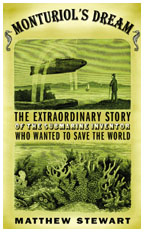September 15, 2004: Reading Room
Matthew Stewart ’85 wrote about an inventor who viewed the underwater world as an escape from the evils of 19th-century Barcelona. (courtesy Pantheon Books) |
Utopia
under the sea
Matthew Stewart ’85 resurrects inventor of first submarine
By Louis Jacobson ’92
When Matthew Stewart ’85 was young, he heard many a tale from his grandfather about how Narcís Monturiol, a little-known inventor in Barcelona, built the world’s first submarine in 1859. Stewart was initially skeptical: His grandfather, who hailed from the Spanish region of Catalonia, “had a habit of giving fellow Catalans credit for most of the good things that happened in the world,” Stewart recalls. But “some time later I saw it in an old history book, and I started to believe.”
Stewart never forgot about Monturiol and this odd story of a self-taught engineer and utopian social revolutionary who managed to build the world’s most advanced underwater vessel before dying in obscurity in 1885. “I wanted to write a novel based on his life, but it turned out that truth was more interesting than fiction,” Stewart says.
 In
Monturiol’s Dream: The Extraordinary Story of the Submarine
Inventor Who Wanted to Save the World, published by Pantheon Books
in June, Stewart uses the invention and its inventor as his starting point
for a broader social history of 19th-century Barcelona and the history
of maritime technology.
In
Monturiol’s Dream: The Extraordinary Story of the Submarine
Inventor Who Wanted to Save the World, published by Pantheon Books
in June, Stewart uses the invention and its inventor as his starting point
for a broader social history of 19th-century Barcelona and the history
of maritime technology.
Monturiol’s life was indelibly shaped by the Catalonian city of Barcelona — a walled-in warren of wretched housing and dirty factories. Monturiol was moved to action, first as a member of an anti-government militia, then as a pacifist utopian, publishing journals that espoused the separation of church and state, government accountability, and women’s rights.
This utopianism also fed his attempt to build a submarine. Monturiol had once saved the life of a diver who nearly drowned while harvesting coral. Monturiol, Stewart explains, initially saw submarines as tools to improve the lot of coral divers, but he also drew more eccentric connections between his submarine project and the creation of a utopia.
Monturiol, Stewart writes, envisioned the underwater world as a peaceful, untrammeled universe — one quite unlike the corrupted urban environment he knew on land. To its inventor, this particular machine would carry men to a new, more perfect world.
To write the book, Stewart, a politics major at Princeton who earned a doctorate in philosophy at Oxford, learned as much as he could about maritime technology. In his judgment, Monturiol “had far and away the best submarine available anywhere” from 1859 to the 1880s. Monturiol’s most advanced sub featured a double hull, provided its crew with a supply of oxygen, safely handled exhaled carbon dioxide, and offered external lighting and portholes.
The inventor’s main failure was economic: Monturiol went bankrupt
when he failed to convince investors that his submarine could be used
profitably for coral diving. While aspects of his submarine design lived
on in the vessels of his successors, Stewart concludes that Monturiol’s
main influence was cultural. “He inspired a generation of Catalan
writers, artists, educators, and thinkers, and these people in turn were
responsible for the renaissance of Barcelona,” Stewart says. ![]()
Louis Jacobson is deputy editor of Roll Call, a newspaper about Capitol Hill.
BOOK SHORTS
 From Oslo to Iraq and the Road Map — Edward W. Said ’57
(Pantheon). This collection of essays focuses on what Said saw as the
failure of Arab leadership, the lack of truthful, balanced coverage of
Israel’s treatment of Palestinians, and the need for Palestinians
and other Arabs to engage with the progressive elements in Israel. An
outspoken critic of Israeli policy, Said, who died last year, was a professor
of English and comparative literature at Columbia University.
From Oslo to Iraq and the Road Map — Edward W. Said ’57
(Pantheon). This collection of essays focuses on what Said saw as the
failure of Arab leadership, the lack of truthful, balanced coverage of
Israel’s treatment of Palestinians, and the need for Palestinians
and other Arabs to engage with the progressive elements in Israel. An
outspoken critic of Israeli policy, Said, who died last year, was a professor
of English and comparative literature at Columbia University.
 North American Pinot Noir — John Winthrop Haeger ’66
(University of California). This reference book for winemakers and consumers
provides a history of pinot noir and tells readers where top wines can
be found. The author also profiles a number of wineries. Haeger is a former
columnist for Wine & Spirits magazine.
North American Pinot Noir — John Winthrop Haeger ’66
(University of California). This reference book for winemakers and consumers
provides a history of pinot noir and tells readers where top wines can
be found. The author also profiles a number of wineries. Haeger is a former
columnist for Wine & Spirits magazine.
 Successful School Change: Creating Settings to Improve Teaching and Learning
— Claude Goldenberg ’77 (Teachers College Press). Inspired
by 15 years of research and teaching in low-income schools, Goldenberg
offers a model for lasting school reform. The author describes a successful
five-year effort to improve teaching and student achievement at an elementary
school serving a mostly Latino population in the Los Angeles area. Goldenberg
is an associate dean of the College of Education at California State University,
Long Beach.
Successful School Change: Creating Settings to Improve Teaching and Learning
— Claude Goldenberg ’77 (Teachers College Press). Inspired
by 15 years of research and teaching in low-income schools, Goldenberg
offers a model for lasting school reform. The author describes a successful
five-year effort to improve teaching and student achievement at an elementary
school serving a mostly Latino population in the Los Angeles area. Goldenberg
is an associate dean of the College of Education at California State University,
Long Beach. ![]()
By Letizia Allais ’05 and K.F.G.
For a complete list of books received, click here.

